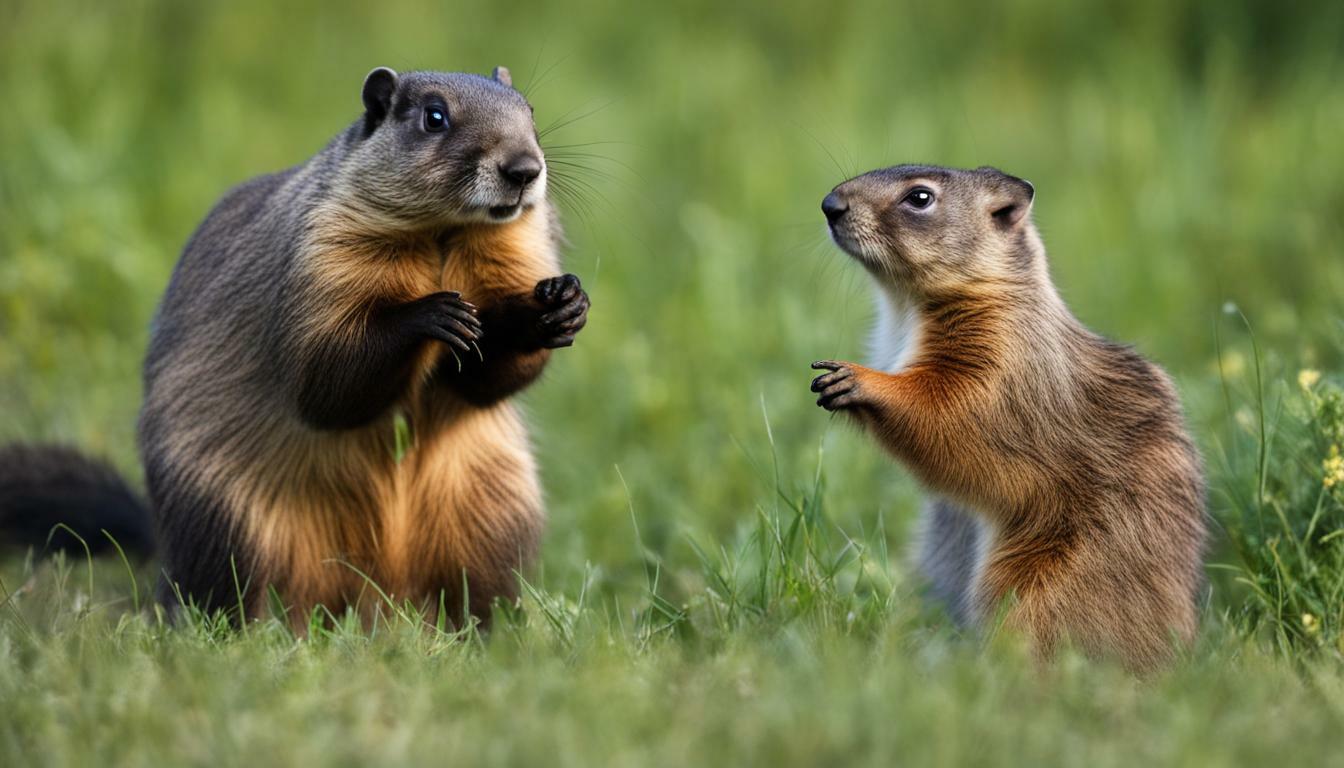Groundhogs can potentially pose a threat to cats, especially small kittens, but understanding their behavior and taking precautions can help ensure the safety of your feline friends.
Key Takeaways:
- Groundhogs are not typically aggressive towards larger cats, but can be a threat to small kittens.
- Preventative measures like removing attractants and installing fences can help keep groundhogs out of your yard.
- Scaring groundhogs away using scents like Epsom salts or lavender can be effective.
- Groundhogs play important roles in the ecosystem, but they can cause damage to gardens and property.
- If your pet is bitten by a groundhog, seek medical attention as they can carry diseases like rabies.
- Coexisting peacefully with groundhogs involves understanding their behavior and taking steps to prevent conflicts.
Groundhog Behavior Towards Cats
Groundhogs are generally not aggressive towards larger cats but may pose a threat to smaller kittens if they feel threatened or cornered. Understanding how groundhogs behave can help cat owners take appropriate measures to ensure the safety of their feline companions.
In most cases, groundhogs will try to avoid confrontations with cats. They are typically shy creatures and will retreat to their burrows if they sense danger. However, if a groundhog feels threatened or trapped, it may exhibit defensive behavior, which can include hissing, chattering its teeth, and even lunging or biting.
To minimize the risk of groundhog attacks on cats, it is important to create a safe and secure environment. This can be done by keeping cats indoors, especially during the spring and summer when groundhogs are most active. If cats do spend time outside, it is crucial to supervise them and ensure they have a way to escape or seek refuge if they encounter a groundhog.
Signs of Groundhog Aggression
It’s essential for cat owners to be able to identify signs of groundhog aggression to protect their pets. Some signs to watch out for include the groundhog standing on its hind legs, making loud vocalizations, or aggressively approaching the cat. If you notice any of these behaviors, it is best to remove your cat from the situation and give the groundhog a clear path to escape.
| Preventive Measures | Benefits |
|---|---|
| Remove attractants from your yard, such as food sources and shelter. | Reduces the likelihood of groundhogs being attracted to your property. |
| Install fences or barriers around your yard. | Creates a physical barrier that prevents groundhogs from entering your property. |
| Use scents like Epsom salts or lavender to deter groundhogs. | Repels groundhogs and discourages them from approaching your yard. |
Remember that while groundhogs play important roles in the ecosystem, it is crucial to coexist with them peacefully and take necessary precautions to protect your cats and property. By understanding groundhog behavior and implementing preventive measures, you can create a safe environment for both your feline friends and the wildlife around you.
Preventing Groundhog Attacks on Cats
Taking preventative measures can greatly reduce the risk of groundhog attacks on your cat and create a harmonious environment for both animals. While groundhogs can potentially harm cats, especially small kittens, they are not typically aggressive towards larger felines. However, it’s always better to be safe than sorry, and there are several steps you can take to protect your furry friend.
First and foremost, it’s important to make your yard less attractive to groundhogs. Remove any potential food sources, such as fallen fruits or vegetables, that might lure these critters into your property. Additionally, consider installing a fence around your yard to create a physical barrier that keeps groundhogs out. Ensure that the fence extends at least one foot below ground level to prevent them from burrowing underneath.
Scaring groundhogs away can also be an effective method. Fill a spray bottle with a mixture of Epsom salts and water, and spray it around areas where groundhogs are likely to visit. The strong scent can deter them from coming near. Alternatively, planting lavender or other plants with strong smells can also help keep groundhogs at bay.
| Preventative Measures to Protect Your Cat from Groundhog Attacks: |
|---|
| – Remove potential food sources from your yard |
| – Install a fence around your yard |
| – Spray Epsom salts and water mixture to deter groundhogs |
| – Plant lavender or other strong-smelling plants |
While it’s essential to prevent conflicts with groundhogs, it’s also important to recognize the valuable role they play in the ecosystem. Groundhogs, also known as woodchucks, help aerate the soil and disperse seeds, contributing to the overall health of the environment. By understanding their behavior and taking steps to coexist peacefully, we can create a balanced and safe cohabitation with these fascinating creatures.
Keeping Groundhogs Out of Your Yard
By implementing certain measures, such as removing attractants and installing fences, you can discourage groundhogs from entering your yard and potentially endangering your cat. Groundhogs are known to be attracted to food sources like vegetable gardens and low-hanging fruits, so keeping your yard free of these temptations can help deter them. Additionally, securing your garbage cans and compost bins can prevent groundhogs from finding easy sources of food.
Installing a sturdy fence around your property can act as a physical barrier, preventing groundhogs from entering. Make sure the fence is buried at least a foot deep to prevent them from burrowing underneath. You can also consider adding chicken wire or mesh underneath the fence to further discourage groundhogs from digging their way in.
If you notice any existing burrows in your yard, it’s important to fill them up promptly. Groundhogs are known for their digging skills and can create extensive networks of tunnels, potentially posing a danger to your cat if they encounter them. Fill the burrows with soil and tamp it down firmly to ensure they won’t be reoccupied.
| Measures to Keep Groundhogs Out of Your Yard |
|---|
| Remove food attractants like vegetable gardens and low-hanging fruits |
| Secure garbage cans and compost bins to prevent easy access to food |
| Install a sturdy fence buried at least a foot deep |
| Add chicken wire or mesh underneath the fence to deter burrowing |
| Promptly fill any existing groundhog burrows in your yard |
Scaring Groundhogs Away
Scents like Epsom salts or lavender can be effective in deterring groundhogs and creating a safer environment for your cat. Groundhogs have a strong sense of smell, and certain scents can act as natural repellents, keeping them at a distance. Sprinkle Epsom salts or lavender oil around your yard, focusing on areas where groundhogs are prone to frequent. The strong aroma will deter these animals, reducing the likelihood of aggression towards your cat.
In addition to scents, there are other methods you can try to scare groundhogs away from your property. Creating noise disturbances can be effective as groundhogs are startled by sudden loud sounds. Use wind chimes, motion-activated sprinklers, or even an air horn to startle them and encourage them to leave. Just make sure to place these deterrents strategically around your yard to cover the areas where groundhogs are active.
Using visual deterrents
Visual deterrents can also help in scaring groundhogs away. Hang shiny objects, such as aluminum foil strips or old CDs, near their burrows or in vulnerable areas of your yard. The reflective surfaces catch the sunlight and create flashes of light, which can startle and confuse groundhogs, making them think twice about entering your property.
It’s important to note that while these deterrents are effective, they may not provide a permanent solution. Groundhogs are persistent animals and may return if they find the environment appealing or if they feel their territory is being threatened. Therefore, it’s crucial to address any potential attractants, such as food sources or shelter, and consider installing fencing around your yard to physically prevent groundhogs from entering.
| Scaring Groundhogs Away | How it Works |
|---|---|
| Epsom Salts or Lavender | Strong scents that repel groundhogs due to their sensitive sense of smell |
| Noise Disturbances | Startle groundhogs with sudden loud sounds, encouraging them to leave |
| Visual Deterrents | Reflective surfaces or shiny objects that create flashes of light to confuse groundhogs |
| Fencing | Physical barrier to prevent groundhogs from accessing your yard |
The Role of Groundhogs in the Ecosystem
Groundhogs play a vital role in maintaining ecological balance, but it is crucial to find a way for cats and groundhogs to peacefully coexist. These burrowing rodents, also known as woodchucks, are considered ecosystem engineers. Their extensive underground burrows provide homes for numerous other species, including snakes, rabbits, and even some reptiles. By creating interconnected tunnels, groundhogs contribute to soil aeration and drainage, which promotes healthy plant growth in their surroundings.
However, it’s important to be aware of the potential conflicts that can arise between cats and groundhogs. Groundhogs, like many wild animals, can display territorial behavior when they feel threatened or cornered. They may respond aggressively towards small cats or kittens if they perceive them as a threat. Therefore, it’s essential to take precautions to ensure the safety of your feline companions.
Preventing Conflicts and Ensuring Safety
To promote peaceful coexistence between cats and groundhogs, it’s advisable to implement preventative measures. Here are some strategies to consider:
- Remove potential attractants: Keep your yard free of food sources, such as fallen fruits or unsecured garbage, that may entice groundhogs.
- Install barriers: Fencing can be an effective way to discourage groundhogs from entering your property. Make sure the fence extends at least a foot below the ground to prevent burrowing.
- Scare tactics: There are natural scents that groundhogs find unpleasant, such as Epsom salts or lavender. Sprinkling these around your yard can deter them from coming near.
| Groundhog Behavior | Preventative Measures |
|---|---|
| Can display territorial behavior | Remove potential attractants |
| May become aggressive if they feel threatened | Install barriers, such as fencing |
| Can be deterred by certain scents | Use natural scents like Epsom salts or lavender |
By implementing these strategies, you can minimize the chances of your cats encountering groundhogs and reduce the potential for conflicts. It’s also crucial to seek medical attention if your cat is bitten by a groundhog, as they can carry diseases such as rabies. Ensuring the safety of both your pets and the groundhogs is essential for a harmonious coexistence.
Potential Damage by Groundhogs
While groundhogs can be harmful to gardens and property, it is important to consider the safety of your cat and take appropriate measures. These furry creatures have a reputation for their burrowing habits, which can cause damage to lawns and gardens. Their burrows can undermine foundations, walkways, and driveways, posing a risk to the structural integrity of your property. Additionally, groundhogs are known to have a voracious appetite for plants, especially vegetables and fruits in gardens.
To protect your cat from potential encounters with groundhogs and prevent damage to your property, there are several steps you can take. One effective method is to install a fence around your yard. Make sure the fence extends at least one foot underground to deter groundhogs from burrowing under it. Another strategy is to remove any attractants that may entice these critters to visit your yard. This includes securing trash cans, removing fallen fruits or vegetables, and keeping your yard free from excess vegetation.
Scaring groundhogs away can also help reduce the chances of a potentially dangerous encounter with your cat. Some scents, like Epsom salts or lavender, are known to be repellant to groundhogs. Sprinkling these scents around your yard or near their burrows can discourage them from sticking around. However, it’s important to note that scare tactics alone may not guarantee a complete solution, especially if groundhogs have already established a presence in your yard.
| Preventive Measures | Effectiveness |
|---|---|
| Installing a fence | Highly effective |
| Removing attractants | Effective |
| Scaring groundhogs away | Moderately effective |
While it’s important to find ways to coexist with groundhogs and appreciate their role in the ecosystem, ensuring the safety of your cat should be a top priority. It is vital to seek medical attention if your cat is bitten by a groundhog, as they can transmit diseases such as rabies. By understanding groundhog behavior, taking preventive measures, and promptly addressing any encounters, you can minimize the potential dangers that groundhogs may pose to your cat and your property.
Seeking Medical Attention for Pet Bites
If your cat is bitten by a groundhog, it is crucial to seek immediate medical attention to prevent the spread of diseases and ensure the wellbeing of your pet. Groundhogs can carry diseases such as rabies, which can be transmitted through bites. Rabies is a serious and potentially fatal disease that affects the nervous system of animals, including cats.
When a groundhog bites your cat, the saliva of the groundhog can enter the bloodstream, potentially introducing harmful bacteria or viruses. Prompt medical intervention is necessary to minimize the risk of infection and to receive appropriate treatment. Your veterinarian will assess the severity of the bite, clean the wound thoroughly, and administer necessary vaccinations or antibiotics to prevent further complications.
What to do if your cat is bitten by a groundhog:
- Isolate your cat: After the bite incident, separate your cat from other pets and children to prevent the potential spread of any diseases.
- Examine the wound: Inspect the bite for any signs of infection, such as redness, swelling, or discharge. Take note of the size and depth of the wound.
- Contact your veterinarian: Call your veterinarian immediately and provide them with a detailed account of the incident. They will guide you on the next steps to take, which may include bringing your cat to their clinic for further examination and treatment.
- Follow the veterinarian’s advice: Your veterinarian will advise you on wound care, potential treatments, and observation periods. It is essential to follow their instructions carefully to ensure the best outcome for your cat’s health.
Remember that prevention is key when it comes to protecting your cat from groundhog bites. Taking measures to keep groundhogs out of your yard and avoiding close encounters between your cat and these animals can greatly reduce the risk of bites and potential infections. By being proactive and seeking immediate medical attention if a bite does occur, you can help safeguard your beloved feline friend’s wellbeing.
| Signs of an infected bite: | Prevention tips: |
|---|---|
|
|
Understanding Groundhog Behavior for Coexistence
By understanding the behavior of groundhogs and implementing appropriate measures, you can create a safe and harmonious environment for both groundhogs and cats. While groundhogs can potentially pose a threat to cats, especially small kittens, they are not typically aggressive towards larger cats and are more likely to be a danger to dogs. However, it is important to take precautionary steps to protect your feline companions.
To prevent groundhog attacks on cats, it is recommended to keep groundhogs out of your yard. One effective method is to remove any attractants that may draw groundhogs to your property, such as exposed food or garbage. Additionally, installing fences can help create a physical barrier, reducing the chances of encounters between groundhogs and cats.
| Groundhog Prevention Tips for Cat Safety: |
|---|
| Remove attractants like exposed food or garbage |
| Install fences to create a physical barrier |
| Consider using scents like Epsom salts or lavender to repel groundhogs |
In addition to these measures, scaring groundhogs away can further reduce the likelihood of conflicts. Scent techniques, such as sprinkling Epsom salts or lavender in areas frequented by groundhogs, can deter them from your property without causing harm. These natural scents are disliked by groundhogs and can be effective in keeping them at bay.
While it is essential to coexist peacefully with groundhogs, it is also important to be aware of the potential damage they can cause. Groundhogs are known for digging extensive burrows, which can undermine the stability of structures and damage gardens. Taking steps to protect your property from groundhog activity, such as reinforcing foundations and using deterrents like wire mesh or gravel, can help minimize these risks.
Remember, if your beloved pet is bitten by a groundhog, it is crucial to seek immediate medical attention. Groundhogs, like many wild animals, can carry diseases such as rabies. Prompt veterinary care can ensure the health and safety of your cat.
By gaining knowledge about groundhog behavior and implementing preventive measures, you can create an environment where both groundhogs and cats can coexist peacefully. Respect for their natural behaviors and habitats will contribute to a safe and harmonious neighborhood for all.
Conclusion
Taking steps to prevent groundhog attacks and promoting coexistence can help ensure the safety and wellbeing of your cat in the presence of groundhogs. While groundhogs can potentially attack and harm cats, especially small kittens, they are generally not aggressive towards larger cats and pose more of a threat to dogs.
To keep groundhogs out of your yard, it is recommended to remove attractants such as food sources and install fences to deter their entry. Scaring groundhogs away with scents like Epsom salts or lavender can also be effective in preventing encounters with your cat.
It is important to recognize that groundhogs play important roles in the ecosystem, but they can cause damage to gardens and property. Therefore, finding a balance between their presence and protecting your cat’s safety is crucial.
If your cat is ever bitten by a groundhog, it is essential to seek immediate medical attention. Groundhogs can carry diseases like rabies, which can pose serious health risks to your pet.
Coexisting peacefully with groundhogs involves understanding their behavior and taking preventive measures. By implementing these strategies, you can minimize the chances of conflict and help create a harmonious environment for both your cat and groundhogs.
FAQ
Will a Groundhog Attack a Cat?
Groundhogs can potentially attack and harm cats, especially small kittens. However, they are not typically aggressive towards larger cats and are more likely to be a threat to dogs.
What is the Behavior of Groundhogs Towards Cats?
Groundhogs may interact with cats in different ways. While they are not typically aggressive towards larger cats, they can pose a threat to small kittens. It’s important to be cautious and take steps to keep cats safe.
How Can I Prevent Groundhog Attacks on Cats?
To prevent groundhog attacks on cats, it is recommended to take preventative measures such as removing attractants from your yard and installing fences to keep groundhogs out. Understanding their behavior can also help promote peaceful coexistence.
How Can I Keep Groundhogs Out of My Yard?
To keep groundhogs out of your yard and minimize the chances of encounters with cats, it’s important to remove attractants, such as food and shelter, and consider installing fences or barriers.
What Methods Can I Use to Scare Groundhogs Away?
Scaring groundhogs away can be done using scents like Epsom salts or lavender. These scents can help deter groundhogs from your property and reduce the likelihood of aggression towards cats.
What Role Do Groundhogs Play in the Ecosystem?
Groundhogs play important roles in the ecosystem, such as aerating the soil and providing homes for other animals. However, it is crucial to find ways to coexist peacefully with groundhogs while ensuring the safety of cats.
Can Groundhogs Cause Damage to Gardens and Property?
Yes, groundhogs can cause damage to gardens and property. They have a tendency to dig burrows and eat plants, which can be harmful to gardens. It’s important to protect cats from potential encounters and mitigate any damage caused by groundhogs.
What Should I Do If My Cat is Bitten by a Groundhog?
If your cat is bitten by a groundhog, it is important to seek medical attention. Groundhogs can carry diseases such as rabies, and timely medical treatment is essential to ensure your pet’s well-being.
How Can I Coexist with Groundhogs and Ensure My Cat’s Safety?
Coexisting peacefully with groundhogs involves understanding their behavior, taking preventive measures to avoid conflicts, and ensuring the safety of your cat. By removing attractants and being aware of potential risks, you can promote a peaceful coexistence with groundhogs.




